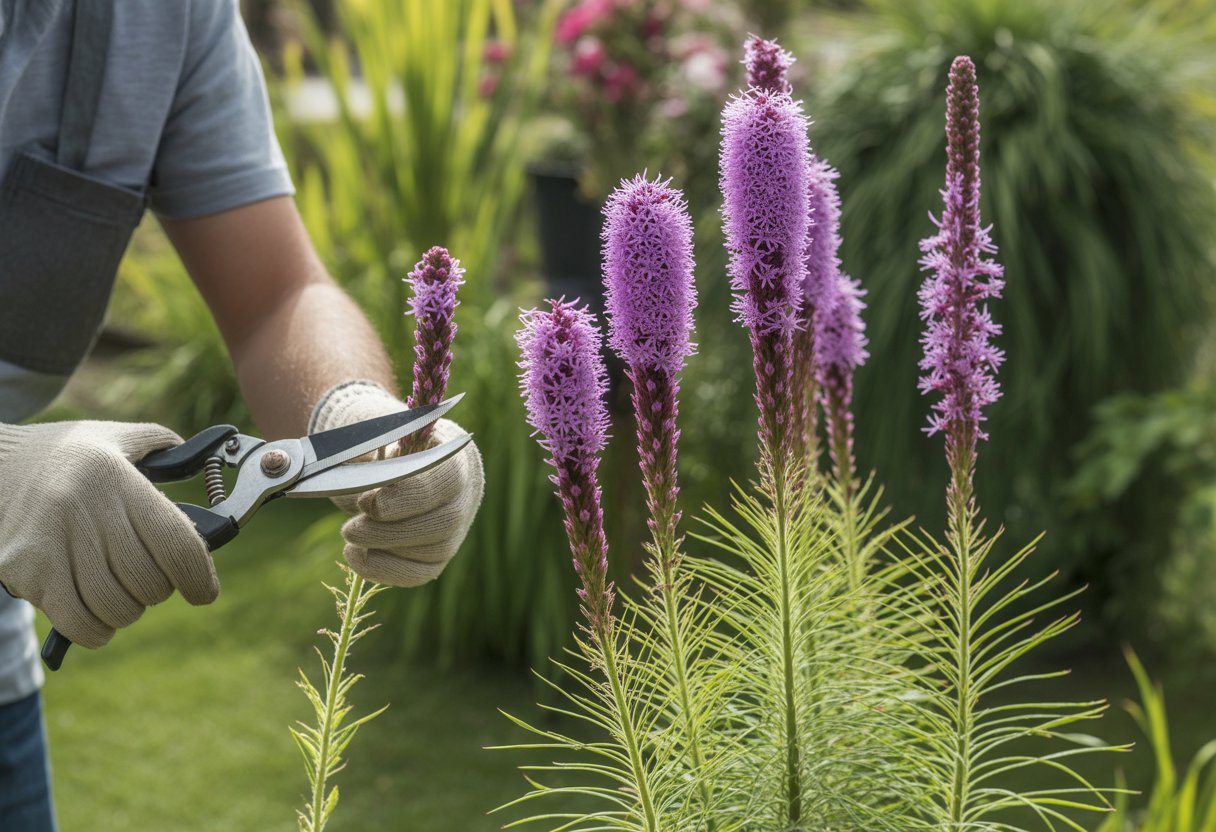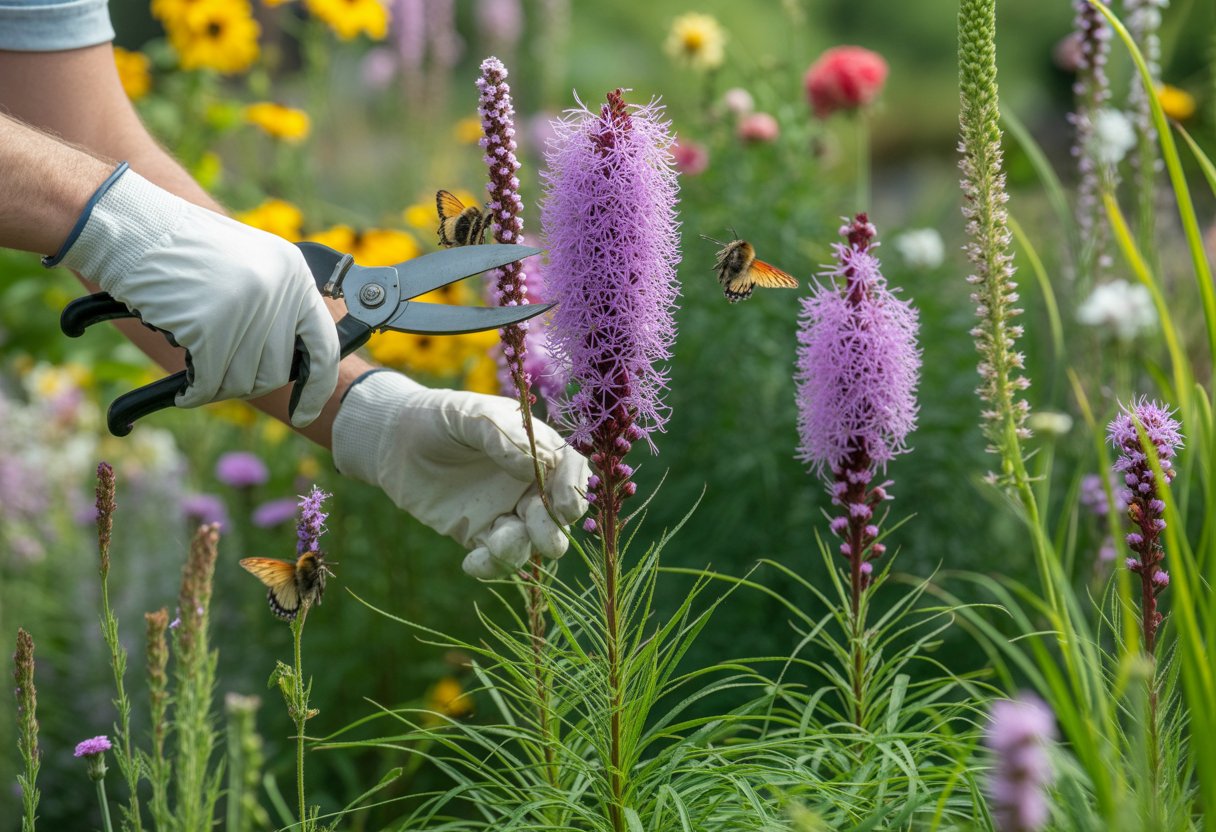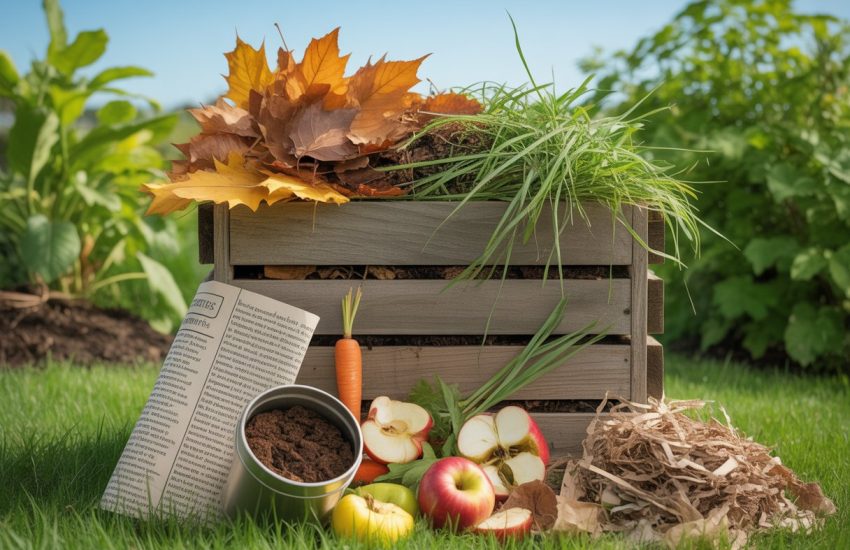How to Prune Blazing Star for Optimal Growth and Blooming
Pruning blazing star—liatris, or gayfeather if you like nicknames—really does help keep these perennials healthy and blooming like champs. By cutting away spent flower stalks and dead leaves, you boost airflow and cut down on disease.
The best way to prune blazing star is to cut back the flower stalks after they finish blooming and trim the entire plant to ground level in late fall or early spring.

Blazing star usually blooms from mid to late summer. If you keep up with pruning, you can stretch out the flowering period a bit.
Gardeners should snip off faded blooms to help the plant focus its energy on fresh growth. Pruning liatris also keeps things looking neat and prevents a tangled mess.
Understanding Blazing Star and Its Growth Cycle

Blazing star is a perennial that stands out for its tall, skinny flower spikes and vivid blooms. If you give it good soil and plenty of sun, it’ll reward you with a reliable pattern of growth and flowering.
Identifying Blazing Star Varieties
Liatris spicata—sometimes called dense blazing star or prairie blazing star—gets most of the attention. It’s got thick, purple flower heads stacked up along tall stems.
The Kobold variety stays shorter, but the flower spikes look just as striking. You’ll find other types too, like Floristan Violet with deeper colors, or some white-flowered versions for a different vibe.
These herbaceous perennials are native to North America. You’ll spot them in wildflower meadows, cottage gardens, or popping up as vertical highlights in beds.
Optimal Conditions for Healthy Growth
Blazing star thrives in full sun. If you want strong blooms, don’t skimp on sunlight.
The roots like well-drained soil with a neutral or just slightly acidic pH. If the ground stays soggy, you’ll risk root rot, so it’s worth improving drainage if needed.
Water regularly when you first plant them, but once they settle in, they’re pretty tough and drought-tolerant. Most people plant blazing star in late fall or early spring so roots can establish before summer.
They’ll grow in pots, but honestly, they look and perform best in garden beds or open meadows.
Blooming Patterns and Seasonal Changes
Blazing star puts out its flower spikes on new growth, usually from mid to late summer. The show can last four to six weeks, so you get a nice stretch of color.
Some varieties might surprise you with a second round of blooms if you cut them back after the first go. Purple is the classic color, but white types can break up the monotony in mixed beds.
As summer winds down, blazing star keeps things lively when other perennials start to fade. By late fall, the plant dies back and goes dormant—this is prime time for pruning and tidying up.
Essential Steps for Pruning Blazing Star
Pruning blazing star isn’t rocket science, but timing and the right tools make a difference. If you keep up with deadheading, you might even coax out a second flush of blooms.
A good cut-back in late fall gets these perennials ready for next year.
When and How to Prune Blazing Star
Wait until late fall, after blooming wraps up, to prune blazing star. Cut the plant back to about six inches above the ground.
By clearing away old stalks and dead leaves, you help the plant save energy for winter and bounce back strong in spring. If you missed anything, trim dead stems in early spring while cleaning up the garden bed.
Don’t go wild with the shears in early summer, or you’ll lose out on flowers.
Deadheading for Enhanced Bloom
Deadheading just means snipping off spent flowers during the blooming season. This nudges the plant to put its energy into new blooms, and sometimes you’ll get a second round.
Use sharp scissors or pruning shears and cut right below the faded flower heads. If you can, deadhead every week or two during peak bloom—your plants will look tidier and keep producing.
Tools and Safety for Pruning
Sharp, clean pruning shears or scissors make the job easier and help you avoid damaging the stems. Disinfect your tools before and after use to keep disease at bay.
Gloves keep your hands safe from rough stems (or the occasional bug). Toss out the pruned material so pests and diseases don’t hang around. It’s worth keeping your tools in good shape for next time.
Aftercare, Pests, and Disease Prevention
After pruning, blazing star still needs some attention. Watering, soil care, and a watchful eye for pests or diseases can keep your plants happy through the seasons.
Post-Pruning Care and Maintenance
Once you’ve pruned, adjust your watering—don’t drown the corms, but don’t let them dry out either. Well-drained soil is key, so keep it moderate and steady.
Clear out dead or damaged leaves to keep air moving around the plant, which helps prevent disease. A balanced fertilizer in early spring gives new growth a boost.
A layer of mulch can protect the corms over winter and help the soil hold moisture. Keep deadheading spent flowers to stretch out the blooming season.
If you spot stress or nutrient problems, act early. It’s easier to fix things before they get out of hand.
Recognizing and Managing Common Pests
Blazing star doesn’t have too many pest problems, but you might see thrips, aphids, or spider mites now and then. Thrips leave silvery streaks on leaves, while aphids cluster on new shoots and suck sap.
Check leaves regularly and treat any infestations with insecticidal soap or neem oil. You can also let beneficial insects like ladybugs handle aphids for you.
Good spacing keeps air flowing, which helps prevent pest build-ups. If you over-fertilize, you’ll get lush growth that pests love—so don’t overdo it.
Disease Prevention and Treatment
Powdery mildew sometimes shows up as white fuzz on leaves, especially if it’s humid and the plants are crowded. Space your plants out and prune thick patches to keep air moving.
Root rot is another risk if soil stays soggy. Make sure it drains well and only water when the top layer is dry.
If you see powdery mildew, remove the affected leaves and try a garden-safe fungicide. For root rot, cut back on watering and fix any drainage issues.
Keeping the bed tidy—like clearing away debris and not watering from above—helps keep pests and diseases in check.
Encouraging Pollinators and Enhancing Garden Display

Blazing star isn’t just pretty—it’s a pollinator magnet. The tall flower spikes bring in bees, butterflies, and even hummingbirds, while adding structure and color to your beds.
If you collect seeds and propagate, you can keep the display going year after year.
Attracting Butterflies, Bees, and Hummingbirds
Blazing star flowers are loaded with nectar, so butterflies, bees, and hummingbirds can’t resist them. During peak bloom—mid to late summer—you’ll see plenty of visitors.
Plant blazing star where it gets lots of sun and don’t cram them together. Space each plant at least 18 inches apart for good airflow and easy access.
Nearby water and skipping pesticides will help pollinators stick around. Keep up with deadheading to extend the bloom and keep nectar coming.
Designing with Blazing Star for Visual Impact
Blazing star’s vertical spikes make bold accents in any garden. Their slender shape stands out against bushier plants like lavender.
If you plant blazing star toward the back, you let their height shine as a backdrop for shorter, spreading flowers. They also work great in cut flower gardens, since their stems hold up well in vases.
Mixing them with softer plants or grasses creates a balanced look. Odd-numbered groupings feel more natural and give the display a little extra flair.
Seed Collection and Propagation Tips
Blazing star seeds grow inside small capsules after the flowers fade. You’ll want to wait until those capsules turn brown and dry before picking them—otherwise, the seeds just aren’t ready.
Shake the dry seed heads over a container, or just use your hands to strip off the capsules. I usually stash the seeds in a cool, dry spot so they don’t lose their spark.
These seeds need a cold period to wake up and sprout well. Try sowing indoors in early spring, but make sure you chill them for 30 to 60 days first. Or, skip the fuss and plant them outside in the fall.
Seedlings take their time to show up, and they really like soil that drains well.
If you’re feeling impatient, you can divide mature clumps in early spring. Splitting up the corms every few years keeps the plants happier and looking good.


